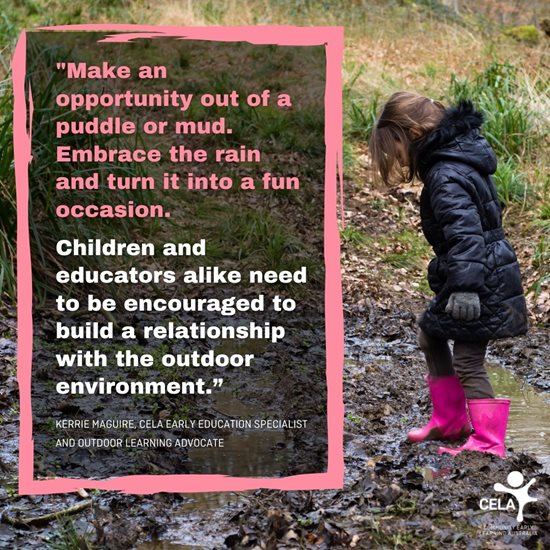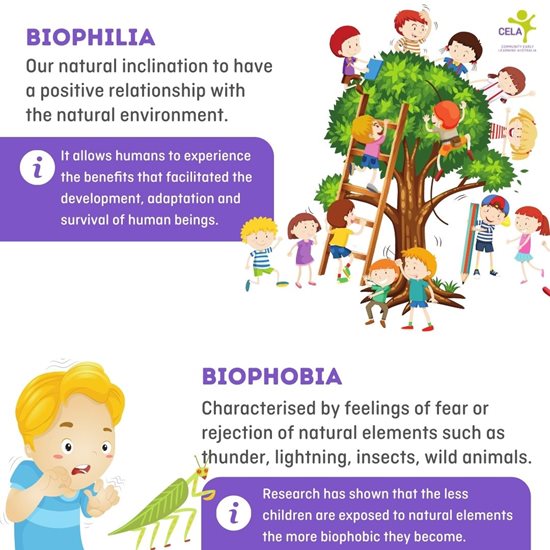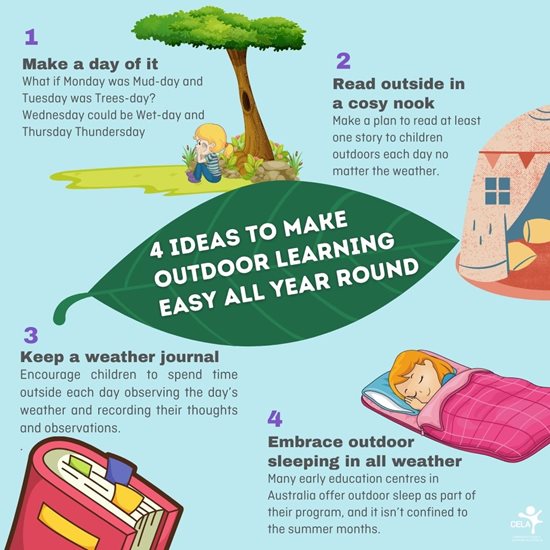During the winter months, it can be tempting to turn the heating up inside and keep children indoors for play, but there are many benefits to getting outdoors, even when it’s cold and rainy. With the more virulent Delta strain of COVID circulating, spending time outdoors is more crucial than ever.
Outdoor learning should be an everyday part of all early education programs. We share some suggestions for how you can get children outdoors no matter what the weather is like, and how you can move through barriers to outdoor programming.
We know that participating in regular physical activity and limiting the time spent being sedentary can have significant benefits for health – studies show children burn more calories outdoors, helping to prevent obesity and strengthen bones and muscles. In addition to that, children are active learners, they learn best through hands-on interaction, play and discovery.
It’s a perfect week to consider how we can put more focus on the outdoors in light of this year’s NAIDOC Week Theme – Heal Country! The theme invites the nation to embrace First Nations’ cultural knowledge and understanding of Country as part of Australia’s national heritage.
For Aboriginal and Torres Strait Islander people, our connection to Country is a central part of our collective cultural wellbeing, but also of our own individual health and wellbeing,” says Dunghutti woman and regular CELA writer Deborah Hoger. “You will often hear Country spoken about as if it is a living, breathing entity, and that is exactly what Country is.
Enabling and empowering children to build this relationship moves this beyond the outdoor environment and creates a connection with country. It can also support children to build a relationship with country beyond the service gate.
Programs designed to expand outdoor learning in Scotland have shown that the biggest initial barriers to take-up are staff confidence in how to deliver quality outdoor learning and encouraging parental engagement. Many ECEC services face similar challenges in Australia.
Here are some ideas on how to move through both of these barriers:
Preparation is the first step
Playing outside in all weather conditions really comes down to one main thing – preparation. And that goes for staff and children.
CELA early education specialist and outdoor learning advocate Kerrie Maguire suggests that educators should plan for outdoor learning by resourcing for it as they would any other kind of learning.

A common excuse for keeping children indoors is their families don’t provide enough changes of clothes or are unhappy when bags of wet clothes are sent home. Waterproof onesies solve this problem. They can be recommended to families or purchased by a centre in bulk.
Wet weather clothing allows children to play freely outdoors. Even babies and toddlers can crawl outside for hours without getting wet. Gum boots and children’s umbrellas are also great to have on hand for playing in muddy puddles and can be purchased cheaply from large retailers.
When we first started to put a focus on year-round outdoor play, the fear mainly came from the parents and staff, says Outdoor Educator Jackie Illiffe, who promotes the centre’s outdoor play philosophy at orientations, initial visits and in all newsletters and family communications.
“It may be that staff are not well equipped and don’t have the right clothing and change of clothes. We purchased raincoats for all staff and we have spare gumboots, raincoats and mud suits for the children who may have forgotten them, or who don’t have any. You can learn a lot from children when they’re out in the rain. You’re looking at the rain from their eyes and seeing new things from their perspective.”
Jackie also shares that staff and children are never forced to go out in the rain or in cold weather, it’s always a choice.
CELA early education specialist Kerrie Maguire recommends having resource boxes for all types of weather so that every outdoor occasion can be catered for.
ACECQA’s ‘Create the perfect play space’ tool is a great document to share at your next team meeting. See page 23 for their recommendations on how to create a ‘rainy day’, ‘windy day’ and ‘sunny day’ resource box.
Moving children and educators from biophobia and biophilia and how this can affect our relationship with the outdoors
Biophilia is our natural inclination to have a positive relationship with the natural environment. It allows humans to experience benefits that facilitated the development, adaptation and survival of human beings.
Biophobia on the other hand is characterised by feelings of fear or rejection of natural elements such as thunder, lightning and wild animals and insects (but can also include mud/dirt/getting wet in the rain).

Researchers have reported that the less children are exposed to natural elements such as wild insects and animals, the more biophobic they become. A recent study in Japan¹ surveyed more than 5,300 school children, examining their perception of local invertebrates (14 insect species and one spider). Most of the students saw the species as things to dislike, fear or go ‘ewww’ to, or even as sources of danger. The less experience the students had with nature, the more negative their feelings. The researchers hypothesised that “The ‘extinction of experience’ – the loss of direct interactions between people and nature – has the potential to increase negative attitudes towards nature.
For children’s natural inclination of biophilia to develop and for children to become stewards of the earth, they must be given developmentally appropriate opportunities to learn about the natural world based on sound principles of child development and learning, says Randy White CEO of White Hutchinson Leisure & Learning Group. This includes developmentally appropriate contact with nature in their early years so they can bond with the natural world, learn to love it and feel comfortable in it.
Increased interaction with nature, including ‘urban greenery’ can also have great benefits for adults. Studies have shown that it can improve our mood, reduce feelings of stress, improve physical health and make you feel more relaxed.
Be clear on the benefits of outdoor learning
According to Nature Play QLD², Outdoor learning has many positive impacts for children, these include:
- Driving self motivated learning
- Increased creativity
- Activating thinking outside the box
- Improving health and wellbeing, social skills and behaviour
- Encouraging better attendance, teamwork and reduced bullying
Download Nature Play QLD's poster via: https://natureplayqld.org.au/wp-content/uploads/2020/11/Benefits-of-Nature-Play-short-WEB-1.pdf
But doesn’t being outside in the cold and rainy weather lead to illness?
There is a myth that cold weather causes illness, however according to Harvard Medical School, it is viruses that cause illness and they tend to survive and replicate better in lower temperatures and lower humidity. People also tend to spend more time together indoors in the colder months allowing viruses to spread more easily in confined spaces. Getting outdoors has benefits all year round, but especially during COVID.
Health, safety and personal preference are of course always important considerations. Outdoor Educator Jackie Illif tells us that they have a lot of large trees in the grounds of their preschool, which can pose a danger to children and staff when days are extremely windy. While children are supported to enjoy the outdoors on most days of the year, the preschool keeps children out of danger on very windy days or those when torrential downpours are happening and makes sure that all children are appropriately dressed for the outdoors, depending on weather.
The importance of outdoor learning is recognised in the NQS
The importance of providing inclusive and sustainable learning environments that maximise and promote children’s learning is reflected under Quality Area 3 of the National Quality Standard (NQS) in particular:
Standard 3.2: The service environment is inclusive, promotes competence and supports exploration and play-based learning.
- Element 3.2.1: Outdoor and indoor spaces are organised and adapted to support every child’s participation and to engage every child in quality experiences in both built and natural environments.
- Element 3.2.2: Resources, materials and equipment allow for multiple uses, are sufficient in number, and enable every child to engage in play-based learning.
- Standard 3.2.3: The service cares for the environment and supports children to become environmentally responsible.
Source: https://www.acecqa.gov.au/sites/default/files/2018-04/QA3_TheEnvironmentAsTheThirdTeacher.pdf
Make a start by creating outdoor focused lesson plans
Research has shown that some educators may view the outdoors as a place for free play only, rather than seeing it as an extension of the indoor classroom.
The Educational Leader plays an intrinsic role in helping educators to identify their own personal and professional barriers to incorporate outdoor learning as part of the program. It should be seen as part of the daily program, not a special activity or a reward. says Kerrie Maguire.
Nature Play QLD is the perfect place to start with planning and programming. Their website is a treasure trove of ideas and inspiration including outdoor learning lesson plans, nature play ideas and resources. Challenge yourself to make at least 50% of your week’s programming outdoors.
Head to the Nature Play Queensland website for some great resources, including outdoor learning lesson plans.
– https://natureplayqld.org.au/outdoor-learning-lesson-plans
– https://natureplayqld.org.au/nature-play-ideas
– https://natureplayqld.org.au/acecqa-nature-play-and-bush-kindy-resources
Four ideas to get you started

1. Make a day of it, every day of the week
Introduce the idea of more outdoor time by devoting a day each week to an outdoor activity.
What if Monday was Mud-day and Tuesday was Trees-day?
Wednesday could be Wet-day and Thursday Thundersday
Friday could be Freezeday, Freshday or Frozenday.
Change it every week if you like, or challenge the children to think of words starting with M,T,W and F that relate to weather or the outdoors.
2. Read outside every day in a cosy nook
Create a cosy outdoor nook or tent that has lots of ventilation where everyone can huddle on weather appropriate matting/dry ground.
Make a plan to read at least one story to children outdoors each day no matter the weather.
Extend the learning from the story by using natural found elements to create characters using natural materials and clay such as leaf and stick monsters.
3. Keep a weather journal
Keep a weather journal where children spend time outside each day observing the day’s weather and recording their thoughts and observations. Extend learning by introducing STEM projects based on weather or investigations into our seasons. Here are some tips on getting started on seasonal reflections from Little Scientists: https://littlescientists.org.au/resources/reflect/australian-seasons/.
4. Consider outdoor nap/sleep times
There is a long cultural tradition of using outdoor spaces for sleep in some colder countries in the northern hemisphere. In many of these countries the practice is believed to establish a connection to nature and to provide health benefits.
Many early education centres in Australia offer outdoor sleep as part of their program, and it isn’t confined to the summer months.
Niki Moodie, Preschool Room Leader at the Rumpus Room in Newcastle, tells us that children at their centre are given the choice between indoor and outdoor activities throughout the day. Offering outdoor sleep was a natural extension of this, and the overwhelming majority of families gave consent for their child to sleep outdoors if they wished.
There is no particular set temperature limit at which The Rumpus Room do not offer outdoor sleep, but comfort and safety is obviously a priority, so the option is assessed on a day by day basis. If The Rumpus Room team feel that they are unable to provide a comfortable and safe space due to weather or outdoor conditions, then indoor sleep will take place instead.
ABOUT THE BENEFITS OF OUTDOOR SLEEP
How much of your programming is outdoors and do you get outside much when it’s cold and rainy? If so, we’d love to know what your favourite outdoor activities are and how you go about facilitating all weather outdoor learning. Add your thoughts in the comments section.
Further reading
https://www.cela.org.au/2021/05/31/heal-country-unpacking-the-naidoc-week-2021-theme
www.cela.org.au/2017/06/08/lets-get-out-of-here-a-story-for-everyone-whos-ever-wanted-to-take-children-beyond-the-safety-gate
https://www.1000hoursoutside.com/blog
https://natureplayqld.org.au
https://www.cela.org.au/2021/05/17/do-you-embrace-year-round-outdoor-sleeping
http://teachertomsblog.blogspot.com/2016/01/if-we-dont-play-in-rain-we-dont-play.html
https://news.sanfordhealth.org/childrens/play-outside
¹https://www.sciencedirect.com/science/article/abs/pii/S0006320719309577
²https://natureplayqld.org.au/blog/benefits-of-outdoor-learning